Bernie Sanders on Criminal Justice
Bernie Sanders believes that the United States squanders far too many resources on mass incarceration and misguided crime policies, and that this money could be better spent providing education, training, and jobs to those who might otherwise get lost in the criminal justice system. Bernie also advocates for police reform through demilitarization, increased transparency, and accountability. He is calling for an end to cash bail, an end to private prisons, an end to the drug war, and legalization of marijuana. Here’s a link to Justice and Safety for All, Bernie’s comprehensive plan to reform the criminal justice system:
“When Bernie is president, we will finally make the deep and structural investments to rebuild the communities that mass incarceration continues to decimate. We must move away from an overly-punitive approach to public safety and start focusing on how to safeguard our communities, prevent the conditions that lead to arrests, and rehabilitate people who have made mistakes.”
Mass Incarceration: There are too many people in prison who aren’t an inherent threat to society, such as nonviolent drug offenders. We have more people behind bars than any other country in the world, a fact Bernie calls an “international embarrassment”.
Police Reform: Bernie believes police forces should be demilitarized and held accountable for abusive practices. Body cameras are necessary to ensure accountability, and we need to prioritize community policing. Bernie is calling for limiting the use of “qualified immunity” and using consent decrees to address systemic constitutional violations by police departments.
End Cash Bail: Nearly half a million prisoners in the U.S. have not been convicted of a crime. They remain in jail because they are too poor to pay cash bail. This is unfair and undemocratic, we must end the discriminatory cash bail system.
Prison Reform: Bernie wants to abolish private prisons, end profiteering in the criminal justice system, and reduce recidivism by focusing on rehabilitating those serving time through education and job training.
Capital Punishment: The death penalty should be abolished. Civilized nations should not execute people convicted of criminal offenses.
Violent Crime: The violent crime rate is going down and has been for decades. Bernie believes many of these crimes can be addressed through more sensible gun control as well as investments in programs that promote better policing and prevent domestic and sexual violence.
Mass Incarceration
In the U.S., 2.3 million people are in prison and 4.6 million more people are on parole or probation. Bernie believes this level of over-incarceration is a misguided policy. The money used for incarceration could be better spent providing jobs and education to those who might otherwise get lost in the criminal justice system. Moreover, Bernie is deeply concerned by how our broken criminal justice system disproportionately targets people of color and the poor.
Start from the beginning. How many people are incarcerated in America?
The U.S. prison population is over 2.3 million. While the United States accounts for only five percent of the world’s population, we are home to 25 percent of the global prison population. People go to jail 10.6 million times each year.
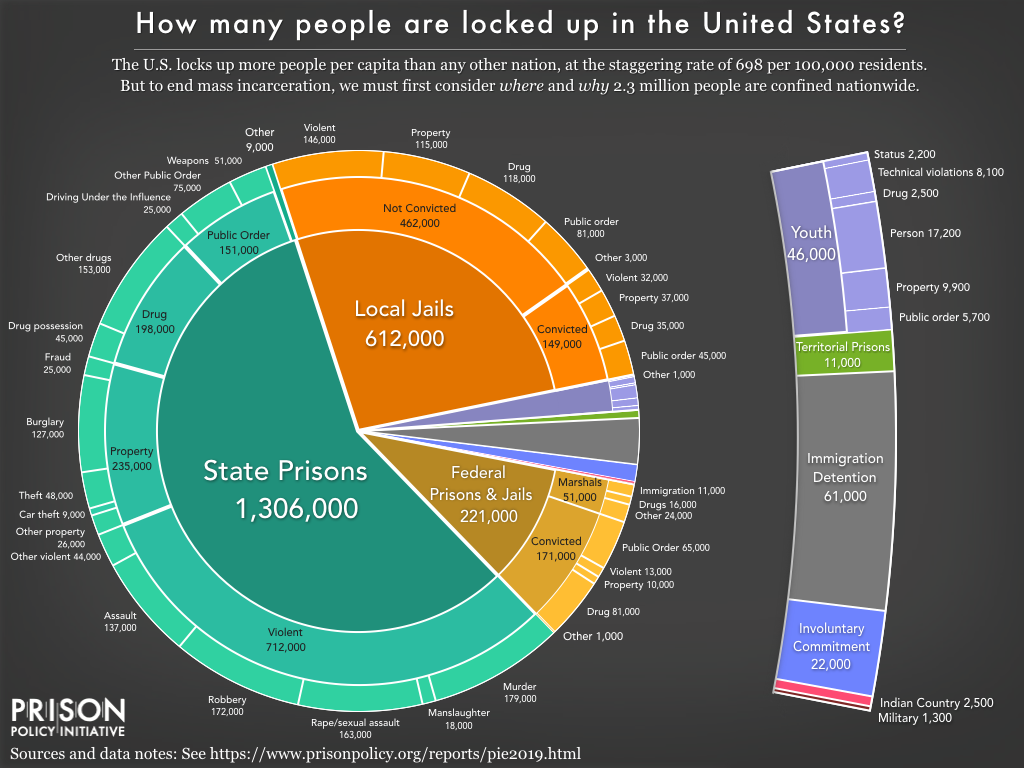
There are an additional 4.6 million people on probation and parole. 6.9 million people, one in every 31 American adults, is under some sort of correctional control. We have more people behind bars than any other country in the world, a fact Bernie calls an “international embarrassment”.
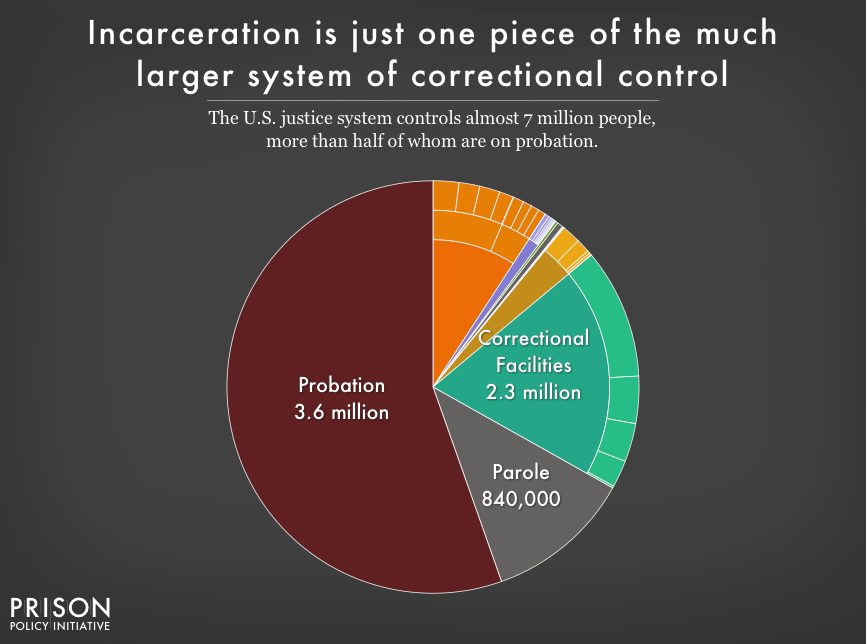
The interesting thing is, America hasn’t always been like this. Here’s how much our incarceration rate has spiked domestically over the last century:
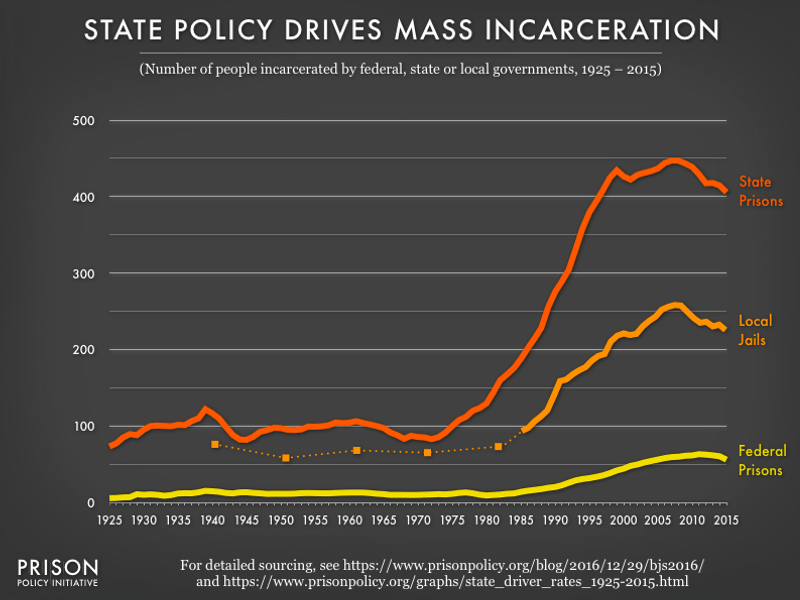
Wow, that’s quite an increase.
This video highlights the racial bias in the American criminal justice system:
How much does mass incarceration cost us?
A lot:
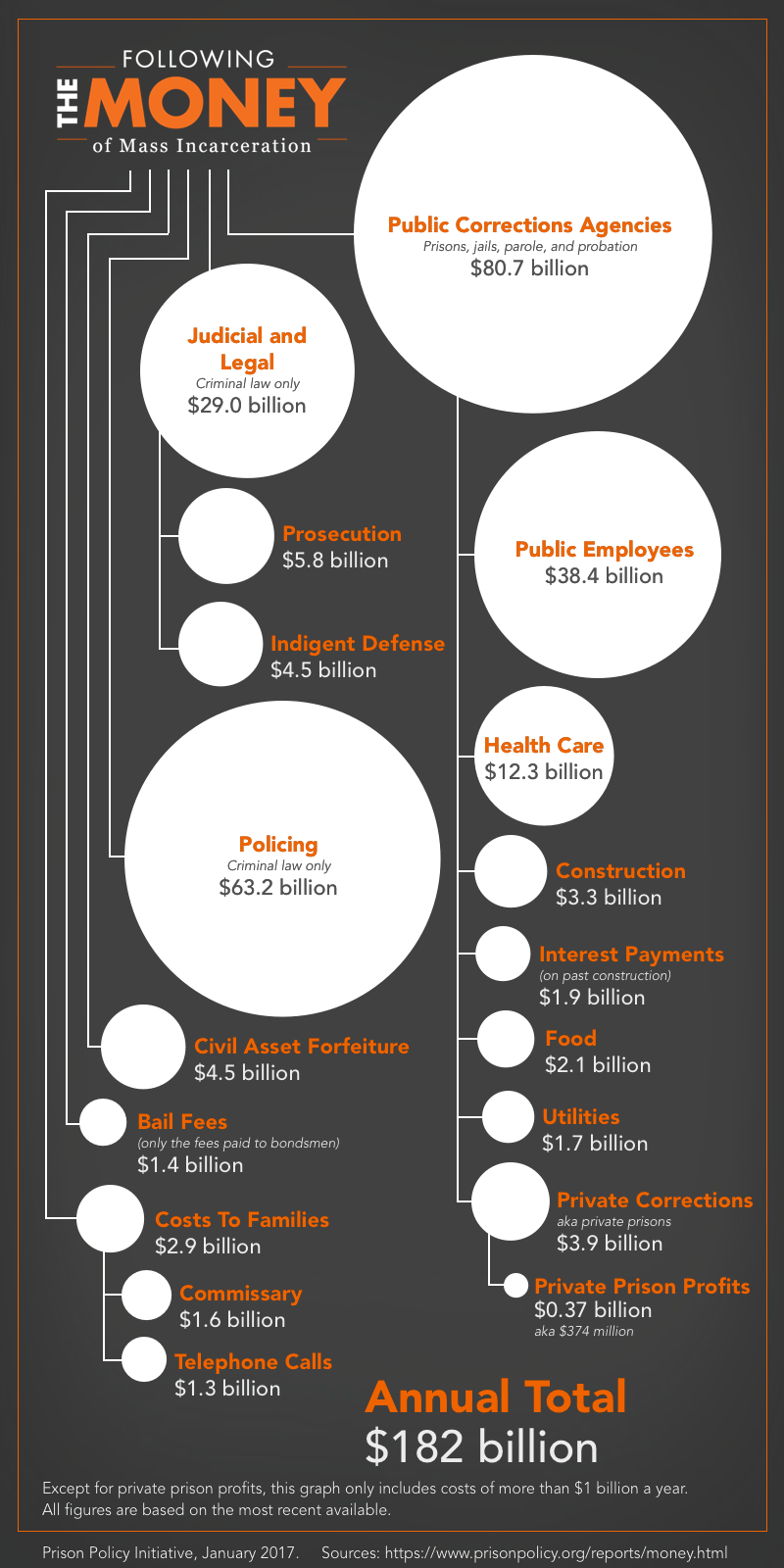
Does prison rehabilitate people and reduce crime?
Regarding rehabilitating people, the answer is no. In fact, incarceration aggravates the situation. Young people who go to jail or juvenile detention centers have decreased literacy rates, can expect lower grades, drop out of school at a higher rate, and end up committing more crime. Beyond suffering from limited access to education or unsafe conditions while in prison, having a criminal record makes it harder to get a job — particularly for blacks.
Regarding reducing crime, the answer is also no. An estimated 68 percent of released prisoners were arrested within 3 years, 79 percent within 6 years, and 83 percent within 9 years.
A 2014 National Research Council report concluded that the “historically unprecedented and internationally unique” rise in incarceration since the 1970s has not been worth the benefit in crime reduction. Indeed, the report recommended that the U.S. revise its current sentencing laws and cut back prison rates.
Tell me more about how mass incarceration affects people of color.
The majority of the U.S. prison population is male and under the age of 40, and a disproportionate amount of them are people of color. Young black males are six times more likely to be arrested than young white males. Of black men aged 20–34 without a high school degree, 37 percent are incarcerated, while only 26 percent are in the workforce.
There are as many people in the U.S. with criminal records as there are with college degrees.
Arrest and incarceration affects many things other than general employment. A conviction creates barriers to certain jobs, or excludes people entirely. Drug convictions can affect the ability to secure financial aid for college. People with criminal convictions may be ineligible for public housing and Section 8 vouchers or may be screened out.
According to a report by the Sentencing Project, one out of three black men can expect to go to prison in their lifetime — compared to one out of 17 whites.
In fact, black individuals are disproportionately overrepresented and overcharged in our current justice system. Watch this video where Bernie discusses his objections to a 1991 crime bill and said, “so-called crime prevention bill… let’s be honest, this is not a crime prevention bill this is a punishment bill”.
Tell me more about the Crime Bill
There were several versions of the crime bill proposed in the early 1990s by Joe Biden. The one most people talk about is the 1994 Violent Crime Control and Law Enforcement Act.
Senator Joe Biden sponsored and pushed the 1994 Crime Bill, which was the largest crime bill in U.S. history. It provided $10 billion in funding for prisons, $6 billion for crime prevention programs, created the three strikes law, and many other controversial provisions. It was signed into law by President Bill Clinton.
Did the bill work to reduce crime?
Not really. These “tough on crime” laws achieved only a slightly decrease crime rates. The National Academy of Sciences published an impressive, comprehensive study on the effects of increased incarceration on crime rates. They found only a modest relationship between incarceration and lower crime rates. A 2015 Brennan Center report found that increased incarceration in the 1990s caused a 6 percent drop in property crime and had no impact on nationwide decreases in violent crime. A 2017 study concluded that incarceration does not make us safer and attributes 75 to 100 percent of the crime reductions to factors other than incarceration.
What did Bernie have to say about the bill at the time?
Bernie denounced an earlier version of the bill as “a punishment bill, a retribution bill, a vengeance bill.” He has always maintained that instead of putting our money into prisons, we should attack the root of crime by investing more in education and economic development. For more on this, see below.
In this video Bernie discusses the crime bill just months before voting on it:
If Bernie was so against this bill, why did he vote for it?
Good question. Bernie admitted at the time that “this is not a perfect bill”, but he understood that certain parts of the bill were tremendously important.
In particular, Bernie was passionate about passing the Violence Against Women Act, one of the key provisions of the Crime Bill. Bernie said at the time, “I have a number of serious problems with the Crime Bill, but one part of it that I vigorously support is the Violence Against Women Act. We urgently need the $1.8 billion in this bill to combat the epidemic of violence against women on the streets and in the homes of America.”
Listen to Bernie explain the importance of this provision as the reason for his support of the Crime Bill:
The 1994 Crime Bill also included a ban on assault weapons, something Bernie promised to support when he ran for the House in Vermont.
Bernie’s sharp criticisms about the ramifications of the Crime Bill prior to the vote turned out to be well-founded. It did lead to mass incarceration among minority communities, including Native Americans and reinforced both the militarization of the police and the War on Drugs.
What else has Bernie said about mass incarceration?
Bernie has been a long-time critic of our justice system’s over-reliance on incarceration as an answer to lower crime rates.
Bernie finds it shocking that South Carolina spends more money on prisons than schools. The cost of keeping people locked up is astronomical, “What’s truly shameful is that last year, South Carolina spent $11,552 on average per student, while spending $21,756 on average per prison inmate – nearly twice as much.”
Bernie has highlighted the “unspeakable tragedy” that, if recent trends continue, one in three black males born in this country can expect at some point in their lives to spend time in prison or jail. Bernie ties criminal activity to lack of economic opportunities, and research shows that people behind bars are more likely to be young people of color who haven’t had access to good education or work training.
As Bernie stated in a June 2015 Senate address:
“It is no great secret that, without work, without education, without hope, people get into trouble… the result is that, tragically, in America today we have more people in jail than any other country in the world.”
So what does Bernie propose we do about all this?
Reduce the number of people in jails
First, Bernie wants to start by reducing the number of people in jails. He wants to ban private prisons and keep nonviolent offenders out of jail by ending cash bail. We’ll talk more about both of these proposals later down the page!
Second, Bernie supports alternative sentencing for non-violent drug crimes and continues to object to mandatory minimums for non-violent offenses. In 2000, he voted yes on an appropriations bill that supported alternative sentences in rehabilitation programs. A 2012 National Criminal Justice Reference Service study reported that effective drug treatment programs can help people with addictions and keep them out of prison.
Third, Bernie wants to end the War on Drugs. He sees the “War on Drugs” as a costly and destructive and ineffective policy. Current drug laws have been futile. After so many billions of dollars spent and so many lives destroyed there has been no real decrease in drug accessibility or use as we see from the opioid epidemic, the rising rates of heroin use and the scourge of meth. Bernie believes treatment, not punishment, is the answer.
On that note, we should legalize marijuana and reform drug laws so people are not arrested and serving long sentences for non-violent offenses. Bernie introduced legislation in the Senate to end the prohibition of cannabis. He cosponsored the Marijuana Justice Act, which would remove marijuana from the Controlled Substances Act (CSA) and the Marijuana Freedom and Opportunity Act, which would federally deschedule cannabis. Bernie is a co-sponsor on 2019 legislation to legalize marijuana.
Learn more at the Drug Policy issue page.
Fourth, Bernie supported the COPS Program, which increased the number of police officers in high-crime areas and has been shown to reduce violent crime.
Fifth, Bernie wants to find solutions to lower the rate of recidivism — the rate at which ex-convicts reoffend. He believes that those who are incarcerated should be empowered through education and job training programs to prepare them to succeed upon release and reduce recidivism rates.
Bernie argues that our nation’s youth, are caught in a crisis, particularly in the black communities, where half of all black males will be arrested by the age of 23. He believes the answer to reducing crime and lowering the staggeringly high incarceration rates for undereducated and underemployed youths requires providing meaningful economic opportunities. Bernie believes it is far more cost-effective and humane to provide “jobs, not jails” and end the school-to-prison pipeline.
Here are a handful of policies proposed by Bernie that will provide more opportunities and jobs. These policies will help reduce the number of youths and young people who are disconnected from meaningful work opportunities, dealing with hopelessness, and not getting the education they deserve:
- A massive infrastructure bill that would put millions of Americans to work on rebuilding America’s crumbling infrastructure.
- A Green New Deal, which would transform our economy and create thousands of jobs.
- A plan to provide job training for at-risk youths.
- Raise the minimum wage to $15.
- The Free College For All Act to make all public colleges and universities tuition-free, so that everyone can afford a higher education.
Improve education
Fifth, Bernie wants to improve education in the United States. Bernie’s plan to reform the education system and reinvest in public schools and teachers, so all children have a chance to learn, would have a huge impact because it is long recognized that illiteracy and crime are closely related. 60 percent of prisoners and 85 percent of juveniles in the juvenile court system are functionally illiterate. Over 70 percent of inmates cannot read above a fourth grade level. In a report on ending recidivism the Department of Justice wrote, “The link between academic failure and delinquency, violence, and crime is welded to reading failure.”
Stop discrimination against people with criminal records
Sixth, Bernie wants to put an end to the discrimination people with criminal records face.
“We do not do a good job of reintegrating those people into society. The result is an enormous amount of pain, human destruction, and a great deal of expense to the American taxpayer.”
See the Education page for more information about Bernie’s plan to overhaul the education system.
Bernie’s comprehensive plan to reform the criminal justice system can be found here. Learn more at the Youth Employment, Minimum Wage and Racial Wage Gap issue pages.
Police Reform
American police tactics, particularly in urban areas, are excessively violent and disproportionately affect people of color, as Bernie discusses in this May 2015 speech:
What’s the scope of the problem?
Police brutality and violence is now a focus of national debate. We’ve struggled as a nation to make sense of videos capturing police killings of unarmed people of color like Eric Garner, Tamir Rice, Walter Scott, Sandra Bland, and many, many, more. Mass media brought attention to this issue after the murder of Michael Brown, initiating the creation of the Black Lives Matter movement. Who can forget the chilling images of the Ferguson, Missouri police preparing for civilian protests by donning military gear and rolling through the streets in tanks?
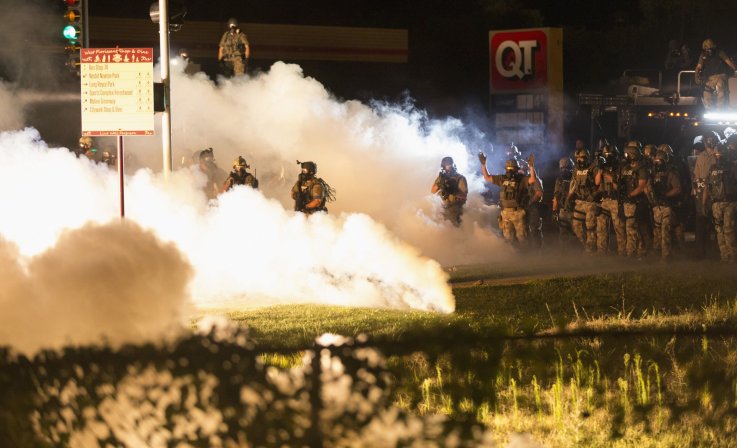
Nationwide police killed nearly 1,000 people in 2017. Police killed 1,165 people in 2018. The people killed are on average 35 years old, so many years of life are lost. Chicago alone spent $500 million from 2011 -2018 to settle police misconduct cases. This site maps police violence across the U.S.
What are some instances of institutional discrimination against African Americans and Hispanics by the police?
Black drivers are stopped by the police at higher rates than white drivers, according to a study by Stanford University.
Black and Hispanic drivers are searched more often than white drivers.
What are the hard numbers behind how police violence disproportionately affects people of color?
While black people make up only 13 percent of the population, they account for 26 percent of all victims killed by police. In 2015, African Americans made up nearly 40 percent of unarmed individuals killed by police with a gun and 42 percent of unarmed individuals that are killed by police by means other than a gun.
Data collected from 2015-2018 shows that African Americans are over-represented among victims of the lethal use of force by police at twice their rate in the general population.
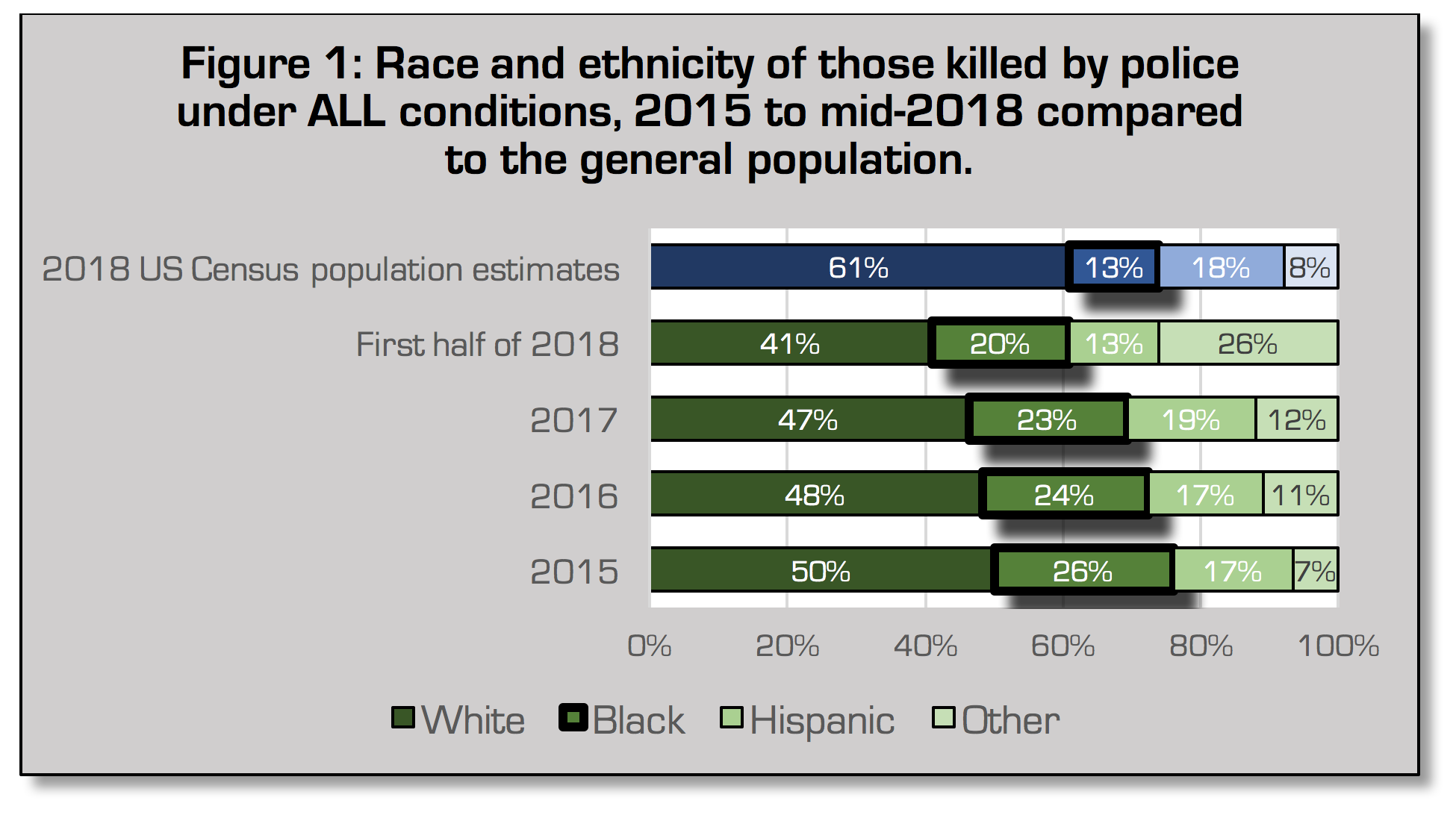
It should be noted that statistics on police shootings are self-reported, so this data probably underestimates the numbers. The FBI has a new National Use-of-Force Data Collection program that began in January 2019. Reporting is by law enforcement agencies and is not mandatory. The goal is to provide a national perspective on the incidents reported, the circumstances, subjects, and officers involved.
Where does Bernie stand on all of this?
Bernie has strongly decried police brutality. In a July 2015 speech to the Southern Christian Leadership Conference (SCLC), Bernie addressed police violence against people of color, “Across the nation, too many African Americans and other minorities find themselves subjected to a system that treats citizens who have not committed crimes like criminals. A growing number of communities do not trust the police and police have become disconnected from the communities they are sworn to protect.”
He continued, “Violence and brutality of any kind, particularly at the hands of law enforcement sworn to protect and serve our communities, is unacceptable and must not be tolerated. We must reform our criminal justice system. Black lives do matter. And we must value black lives.”
Bernie understands that the recent publicized shootings of unarmed black people by the police are not isolated incidents and are not a new problem, “Anyone who thinks this has not been going on decade after decade would be very wrong.”
Bernie’s vision of police reform is not radical. He believes that a “young black man or woman can walk down the street without worrying about being falsely arrested, beaten or killed.”
What does Bernie propose we do to deter police misconduct?
Bernie has spoken very strongly on the urgent need for police accountability. In particular, Bernie focuses on demilitarizing the police, believing that all the money we put into heavy equipment and arms should instead be put toward community policing, jobs, and education. Internal police reviews are insufficient, the police cannot police themselves. Strong citizens review boards need the power to call witnesses and access records so they can make informed decisions to absolve or recommend discipline of an officer who has engaged in misconduct.
As with any big problem, Bernie thinks it’s a good idea to address the problem from the bottom up. He supports community policing, which “stresses interaction over reaction, de-escalation over brute force, and that police should have a stake in the communities they serve.”
The question, as Bernie identifies it, is, “How do you have police departments in this country that are part of their communities, not oppressors in their communities?”
What community policing means in practical terms is changing who becomes a police officer, why they become police officer, and what they do once they are a police officer. Here are some policies that would make a huge difference in how policing in America is conducted:
- Increase education and training requirements for officers
- Train all police in dispute resolution and de-escalation techniques
- Taser and pepper spray should not be used to force compliance
- Require police to live in the neighborhoods where they patrol
- Recruit from minority neighborhoods.
- Allow qualified people with non-violent offenses to become police
- Involve the community in decisions affecting their neighborhood
- Cooperate with communities to solve problems
Bernie is a supporter of police body cameras to discourage, detect, and eliminate misconduct, and supports increasing federal funds to municipalities that implement them.
For more information read Bernie’s comprehensive plan to reform the criminal justice system.
End Cash Bail
“We are spending $80 billion a year to lock up 2.2 million people, hundreds of thousands of whom have not been convicted of a crime and are solely in jail because they can’t afford their bail. We are criminalizing poverty. And because of the historical legacy of racism in this country, we are disproportionately criminalizing African Americans, Latinos, and Native Americans.” – Bernie Sanders, 2019
Nearly 465,000 people in U.S. jails have not been convicted of a crime. Many remain in jail for days, weeks, or even years simply because they cannot afford their bail. As a consequence, they may lose their housing, their job, and their children. Essentially, the cash bail system makes it a crime to be poor.
Bernie believes we must end the cash bail system. He has said, “Nearly half a million people sitting in jail haven’t been convicted of any crime—simply because many accused of a crime can’t afford bail. We must end cash bail as part of reforming our entire criminal justice system.”
And so, Bernie introduced the No Money Bail Act in 2018 to “end the travesty of cash bail and aim to keep people from being locked up before trial solely because they cannot afford their bail.” It is the right thing to do and it will save around $14 billion of taxpayer money that’s spent on pretrial detention each year.
Prison Reform
The current profit-driven prison system is unjust and ineffective. The conditions in some prisons are unconstitutionally bad. Bernie wants to dismantle the prison industrial complex and limit federal tax breaks to private prisons. Additionally, he believes those incarcerated should be rehabilitated through education and job training to prepare them for success upon release and to reduce recidivism rates. America has over-invested in prisons to the point that there are more prisons than colleges in the country.
Why is the prison system itself a problem?
The U.S. prison population has risen 790 percent since 1980. Incarceration in private prisons shot up 37 percent between 2002 and 2009 alone. Privatized prisons do little to benefit their local communities, despite their promises. Also, many of these facilities fail to comply with state laws and maintain “abysmal conditions” for their prisoners. Moreover, prison doesn’t rehabilitate. Studies from the Bureau of Justice Statistics find that released prisoners are very likely to get rearrested.
What would Bernie do to reform the prison system?
Bernie wants to close a tax loophole that allows private prisons to avoid paying corporate income taxes. He also introduced the Justice is Not For Sale Act of 2015, which would have banned private prisons entirely. You can watch him introduce the bill.
In a 2016 op-ed, Bernie discusses his many reasons for banning for-profit prisons.
Here’s a list of reasons why Bernie wants to ban private prisons:
- Private prisons harm minorities
- Prisoners are abused: underfed, assaulted, patients are abused, assaults encouraged
- Immigrants are being victimized
- The prisons profit from abuse and mistreatment
- Prison industry money is corrupting the political process
- The prison lobby influences prison policy and immigration policy
- Prison families are being exploited
- Young people are being mistreated and exploited
Bernie is also calling for an end to prison labor. In May 2019, he wrote an essay which explains his reasoning.
In 2018, US prison inmates staged a nationwide strike over “modern slavery.”
Some prisoners were thrown in solitary confinement to stop the strike. The federal government markets prison labor to businesses as a way to save on labor costs. Prisoners work for very low or no wages while doing work that includes answering customer service phone calls, fighting wildfires, packaging Starbucks coffee, and producing consumer goods such as lingerie.
Remove other financial incentives to incarcerate
There is a profit motive for arresting and jailing people, especially youths. Even in prison you are a citizen and have the right not to be abused and mistreated to increase profits. Bernie believes the profits encourage even more incarceration and gives the prison industry influence over prison policy and immigration policy which allows them to corrupt the political process and build even more prisons.
Restore the federal parole system
The Justice is Not for Sale Act would’ve also brought back the federal parole system to help reduce the proliferation of mass incarceration, and remove the inhumane quota for the number of undocumented immigrants held in detention.
Eliminate mandatory minimum sentencing
Bernie wants to keep nonviolent offenders out of prison with alternative sentencing, which is a fancy term for rehabilitation and community service programs. He wants to eliminate mandatory minimum sentencing, which is one of the primary drivers behind the dramatic increase of nonviolent drug offenders in the prison population. That’s why he also wants to reform U.S. drug policy.
Learn more at the Drug Policy issue page, and in the Mass Incarceration section above.
Give voting rights to prisoners
“You’re paying a price, you committed a crime, you’re in jail. That’s bad,” Bernie Sanders said. “But you’re still living in American society and you have a right to vote. I believe in that.” – Bernie Sanders, April 2019
Bernie believes that felons should be allowed to vote from prison. Prisoners are counted in the census as residents on a state in the census. They should be allowed to vote and not just be used as a gerrymandering tool. Prisoners already have the right to vote in Maine and Vermont.
Focus on rehabilitation and reintegration
The corrections system needs to focus more on rehabilitation. Bernie was one of the few members of Congress to oppose cutting off prisoners from the Pell Grant program, which gave them access to higher education and was shown to dramatically reduce recidivism. Literacy programs would also have a huge impact.
That is why Bernie cosponsored a bill introduced by Senator Brian Schatz (D-HI) known as the Restoring Education and Learning Act. This bill would restore the eligibility of federal Pell Grants for the incarcerated population and the prison population that has been released from jail.
Bernie is acutely aware of the interrelation between crime and economic opportunity. For this reason, he would focus on creating jobs and job training programs for America’s youth, as well as fund a system of free public college tuition. He’s also calling for changes since 2015 that prevent employers from discriminating against applicants based on criminal history by “banning the box.”
For more information, check out the Education, Youth Employment, and Economy pages and Bernie’s comprehensive plan to reform the criminal justice system.
Capital Punishment
Bernie’s platform on capital punishment is unequivocal — he wants to abolish the death penalty, he favors life imprisonment over capital punishment. In 2016 the Democratic Party, and Bernie endorsed abolishing the death penalty.
In response to learning that the 166th innocent prisoner had been freed from death row in the U.S., Bernie simply said, “Abolish the death penalty.”
What’s the state of the death penalty in America?
Two-thirds of countries around the world have abolished capital punishment. The U.S. has not. The majority of all executions take place in five nations: China, Iran, North Korea, Yemen, and the United States.
An Amnesty International report found the death penalty in America, is problematic for a number of reasons: racial bias, arbitrary use, disregard for mental illness, high fiscal costs, non-deterrence of violent crime, and the claiming of innocent lives due to wrongful convictions.
How do most Americans feel about the death penalty?
Support for capital punishment is near historic lows, with just 54 percent of Americans supporting it.
What has Bernie said about the death penalty?
You can listen to his own words, in an interview he said, “I just don’t think the state itself…should be in the business of killing people. So when you have people who have done terrible, terrible things, they’re going to spend the rest of their lives in jail and that’s a pretty harsh punishment. But I am against capital punishment.”
So what actions has Bernie taken to reduce the use of capital punishment?
In 1991, as a Congressman, he called for the end of “state murder”:
In 1994, Bernie voted for an amendment to the Crime Bill that would replace the death penalty with life imprisonment. In 1998, he voted for a bill that required life imprisonment over capital punishment in any case where the defendant’s guilt is uncertain.
Civil Asset Forfeitures
Civil forfeiture allows the police to seize, then keep or sell, any property they claim is involved in a crime. Owners don’t need to be arrested or convicted of a crime for their cash, cars, or real estate to be taken away.
I didn’t know this was happening. What is Bernie doing about it?
Bernie is calling for serious reform to civil asset forfeiture and a ban to the practice of any law enforcement agency benefiting from civil asset forfeiture.
Violent Crime
Violent crime is going down and has been for decades. At its peak in 1991, the number of murders was 24,703. In 2016, the country had 17,250 murders. Bernie does not believe that mass incarceration is effective in reducing violent crime, instead he advocates for addressing income inequality, sensible gun control, better policing programs, and more funding to address domestic and sexual violence. The three maps below illustrate Bernie’s point, that the key to addressing violent crime is not throwing people in jail, which is accomplishing very little, but in reducing unemployment and creating economic and educational opportunities in low income areas.
Below is a map that shows the places with the highest rates of violent crimes murder, rape, robbery, and aggravated assault. The areas in green have the lowest rates, the areas in red have the highest rates.

This map shows the areas where people are incarcerated. The areas where more people are in prison are the places where more violent crimes continue to be committed despite the high incarceration rates.
This map shows the counties that have the highest unemployment rates. As Bernie has long argued, the areas with high violent crime rates are the same areas that lack job opportunities.
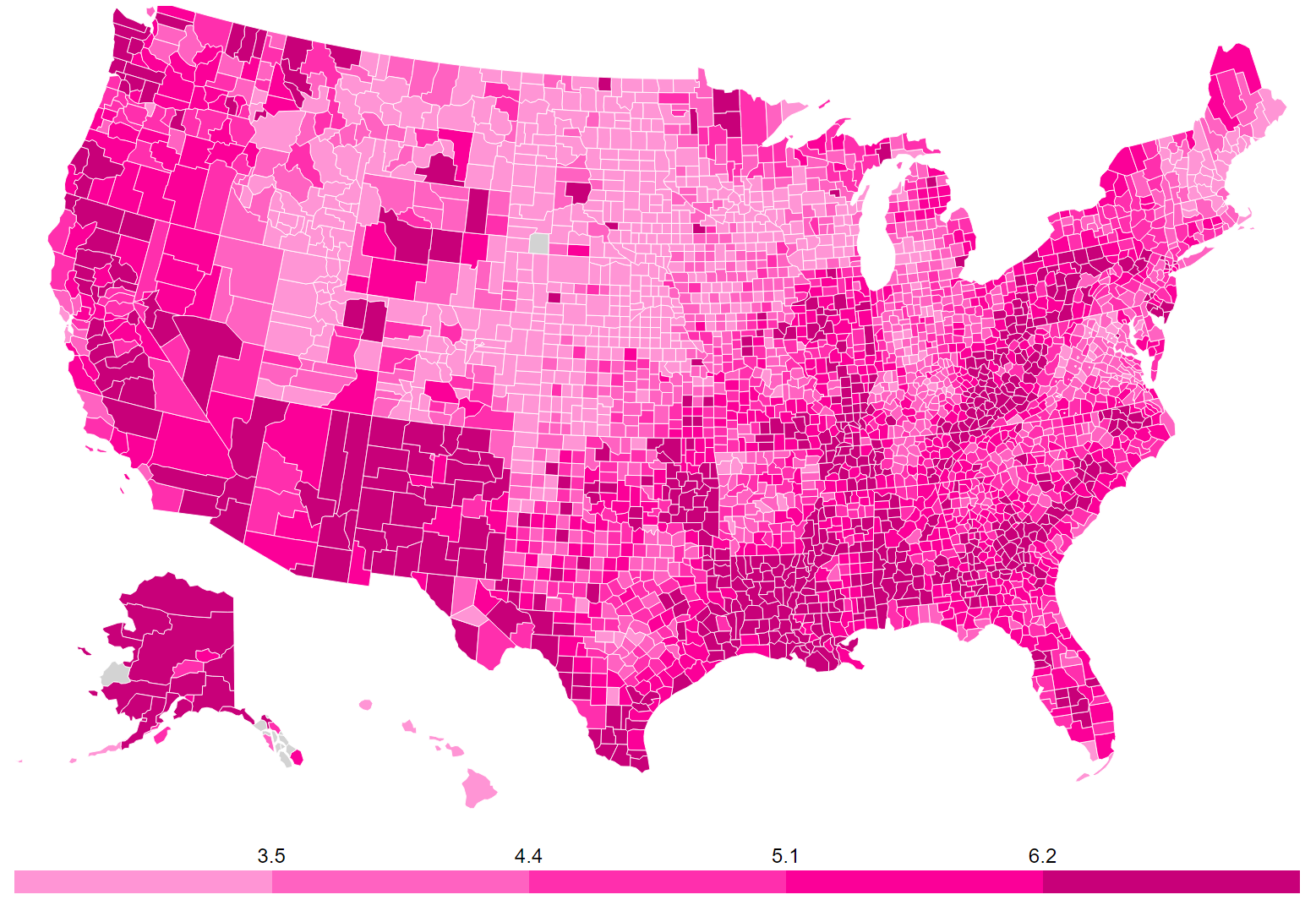
This National Research Council study and this 2015 Brennan Center report both found only a modest relationship between incarceration and lower crime rates. The Brennan Center report specifically found that increased incarceration in the 1990s had no impact on nationwide decreases in violent crime. A 2017 study concluded that incarceration does not make us safer and attributes 75 to 100 percent of the crime reductions to factors other than incarceration.
The economic influence on crime has long been ignored. Bernie is calling for that to change.
Where does Bernie stand on gun crime?
Bernie has voted in favor of requiring background checks to prevent firearms from getting into the hands of felons and the mentally ill, passing a federal ban on semi-automatic weapons, and closing loopholes that allow private sellers at gun shows and on the internet to sell to individuals without background checks. Bernie has also voted in favor of a national instant background check system.
But he doesn’t believe gun control will solve all our problems. Bernie believes that we have a crisis in addressing mental health issues in this country, saying in a recent interview:
“We need strong sensible gun control, and I will support it. But some people think it’s going to solve all of our problems, and it’s not. You know what, we have a crisis in the capability of addressing mental health illness in this country. When people are hurting and are prepared to do something terrible, we need to do something immediately. We don’t have that and we should have that.”
Given that many perpetrators of mass shootings have been found to suffer from mental health issues, Bernie believes that expanding access to mental health care can address some of the root causes of gun-related violent crime.
Learn more about Bernie’s stances on mental health care access here and on guns at the Gun Policy issue page.
And how about his record and policies on domestic and sexual violence?
Domestic violence accounts for 15 percent of all violent crime. Additionally, one in five women (and one in 71 men) in the U.S. have been raped. Almost half of victims of either gender are raped by an acquaintance, and almost 45.4 percent of female rape victims and 29 percent of male rape victims were raped by an intimate partner.
Bernie believes that the rates of sexual and domestic violence against women — and men — is too high, and that “much more has to be done.”
Bernie voted in August of 1994 to authorize the Violence Against Women Act (VAWA), which authorized $1.6 billion towards investigating and prosecuting domestic and sexual violence, and created the Office on Violence Against Women. Since the VAWA was enacted in 1994, incidents of domestic violence against women have dropped more than 50 percent.
In 2013, Bernie was a cosponsor of the Reauthorization of the Violence Against Women Act that included additional provisions to protect LGBT victims, and noted its contributions into reducing domestic violence in many communities. As President, Bernie will reauthorize the Violence Against Women Act and provide resources to women who experience sexual assault and domestic violence.
What about men? They suffer from abuse, too!
It’s absolutely true that men are victims of domestic violence, and Bernie supports all victims of domestic violence. Although the Violence Against Women Act includes only “women” in its title, the operative text is gender-neutral and applies to men and women, including transgender people.
